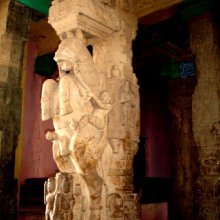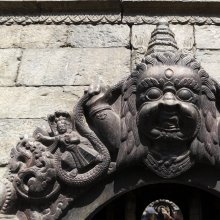Temple architecture: 3 definitions
Introduction:
Temple architecture means something in Hinduism, Sanskrit, the history of ancient India. If you want to know the exact meaning, history, etymology or English translation of this term then check out the descriptions on this page. Add your comment or reference to a book if you want to contribute to this summary article.
Images (photo gallery)
In Hinduism
Shaivism (Shaiva philosophy)
Source: Google Books: Manthanabhairavatantram (shaivism)Temple architecture is a major concern of the Siddhānta Āgamas current in South India. Thus, it is remarkable that they are not discussed at all in other early Śaiva Aagamas. Indeed, early manuscripts of Siddhānta Āgamas recovered in Nepal do not deal with this subject at all. Similarly, South Indian Vaiṣṇava Saṃhitās also discuss temple architecture (although less than their Śaiva counterparts). In this case also, this subject is not treated in the earliest Vaiṣṇava sources. It appears, therefore, that temples are not essential for Tantric rituals. However elaborate and extensive they become, these ‘abodes of the gods’ (devālaya), remain essentially three dimensional maṇḍalas.

Shaiva (शैव, śaiva) or Shaivism (śaivism) represents a tradition of Hinduism worshiping Shiva as the supreme being. Closely related to Shaktism, Shaiva literature includes a range of scriptures, including Tantras, while the root of this tradition may be traced back to the ancient Vedas.
Purana and Itihasa (epic history)
Source: Shodhganga: Elements of Art and Architecture in the Trtiyakhanda of the VisnudharmottarapuranaThe Temple Architecture of ancient India bears great significance among the different styles of Architecture. In temple Architecture, most of the members or elements of a temple are carved and those sculptured architectural pieces proofs Architecture as an Art. S.P. Gupta also agrees on it and considers Architecture as an Art in his work “Elements of Indian Art”. Hindu temple Architecture is the principal form of Hindu Architecture. Though there are varieties of styles of temple Architecture, the basic nature of the Hindu temple remains same.
The following are some of the basic elements of Hindu temples (names are in Sanskrit).—jagatī, bhūmikā, kaṭi, kūṭa, śikhara, garvagṛha, maṇḍapa, candraśālā, āmalaka, kalaśa etc. The temples are said to be built in definite rules and processes. There are some ancient works viz. Brihatsamhita of Varahamihira, Mayamata of Mayamuṇi, Manasara, Samaranganasutradhara etc. bears plenty of important information about Hindu temple Architecture and design. Puranic literature also deals with the construction of temples of ancient India. Among those Puranas the Vishnudharmottarapurana has a detailed discussion on the Architecture of temples of ancient India.

The Purana (पुराण, purāṇas) refers to Sanskrit literature preserving ancient India’s vast cultural history, including historical legends, religious ceremonies, various arts and sciences. The eighteen mahapuranas total over 400,000 shlokas (metrical couplets) and date to at least several centuries BCE.
India history and geography
Source: Shodhganga: Elements of Art and Architecture in the Trtiyakhanda of the Visnudharmottarapurana (history)The Hindu Temple Architecture bears a great importance in the field of fine art along with various principles of life like that of beliefs, philosophy, ideas, social norms etc. Thus temple many times exhibit the way of life under Hinduism. From the ancient time the art of temple building has been developing in almost all the regions of India. The different architectural techniques of temple building in different regions are the result of geographical, climatic, ethnic, cultural, national and historical diversities.

The history of India traces the identification of countries, villages, towns and other regions of India, as well as mythology, zoology, royal dynasties, rulers, tribes, local festivities and traditions and regional languages. Ancient India enjoyed religious freedom and encourages the path of Dharma, a concept common to Buddhism, Hinduism, and Jainism.
See also (Relevant definitions)
Partial matches: Architecture, Temple.
Full-text (+20): Prasada, Matrisadbhava, Vastupurushamandala, Ishanashivagurudevapaddhati, Vishnusamhita, Prayogamanjari, Devyamata, Kamikagama, Cola, Tanjavur, Way of life, Prastara, Vedi, Shilparatna, Padamana, Prasadabhushana, Bhumilamba, Sthupikalakshana, Adhishthana, Arcavatara.
Relevant text
Search found 33 books and stories containing Temple architecture; (plurals include: Temple architectures). You can also click to the full overview containing English textual excerpts. Below are direct links for the most relevant articles:
Vishnudharmottara Purana (Art and Architecture) (by Bhagyashree Sarma)
4. A General Note on Architecture < [Chapter 1 - Introduction]
4. The Viṣṇudharmottara-purāṇa and Temple Architecture of India < [Chapter 6 - Modern Relevance of Different Art Forms and Architecture]
1. Origin and Development of Temple building < [Chapter 4 - Temple Building]
Vastu-shastra (5): Temple Architecture (by D. N. Shukla)
Layanas, Guhādharas and Guhārājas < [Chapter 12 - History of Hindu Temples (Prāsādas and Vimānas)]
Vastu-shastra (1): Canons of Architecture (by D. N. Shukla)
(vii.c) Śilparatna (Temple-architecture—Chapters 14-43) < [Chapter 5 - Study of Hindu Science of Architecture]
(v,9-10) Vāstu in the Pratiṣṭhā and Miscellaneous works < [Chapter 4 - An outline History of Hindu Architecture]
Kashyapa Shilpa-shastra (study) (by K. Vidyuta)
3. Temple Architecture (Prāsāda or Vimānā) < [Chapter 1 - Introduction]
2 (b). Vāstuśāstra texts < [Chapter 1 - Introduction]
Samarangana-sutradhara (Summary) (by D. N. Shukla)
Temples of Munnur (Historical Study) (by R. Muthuraman)
Related products


